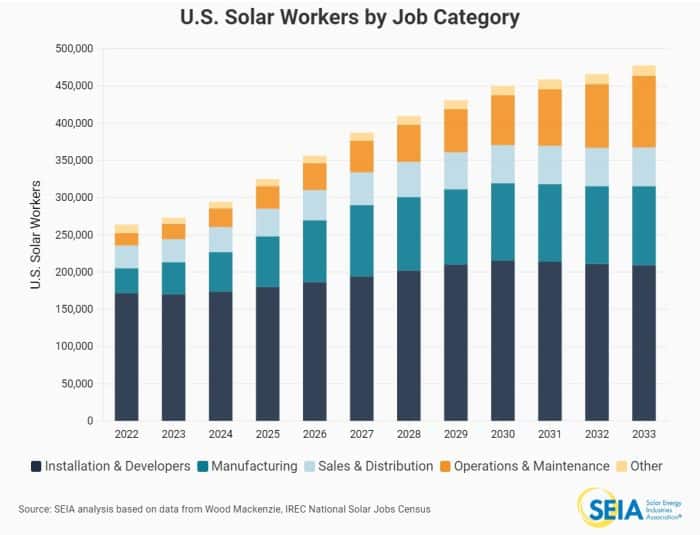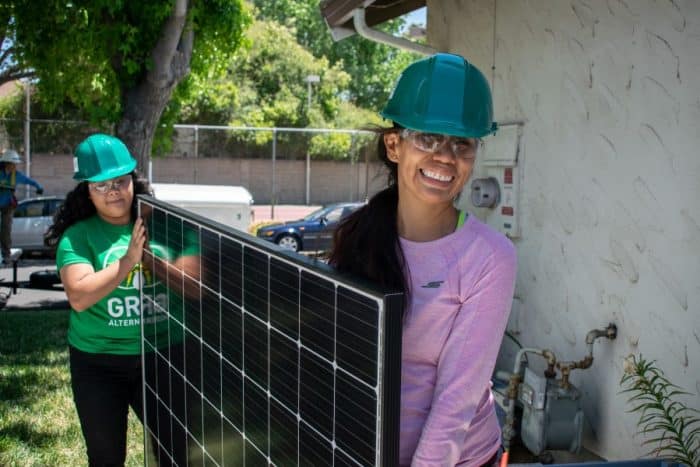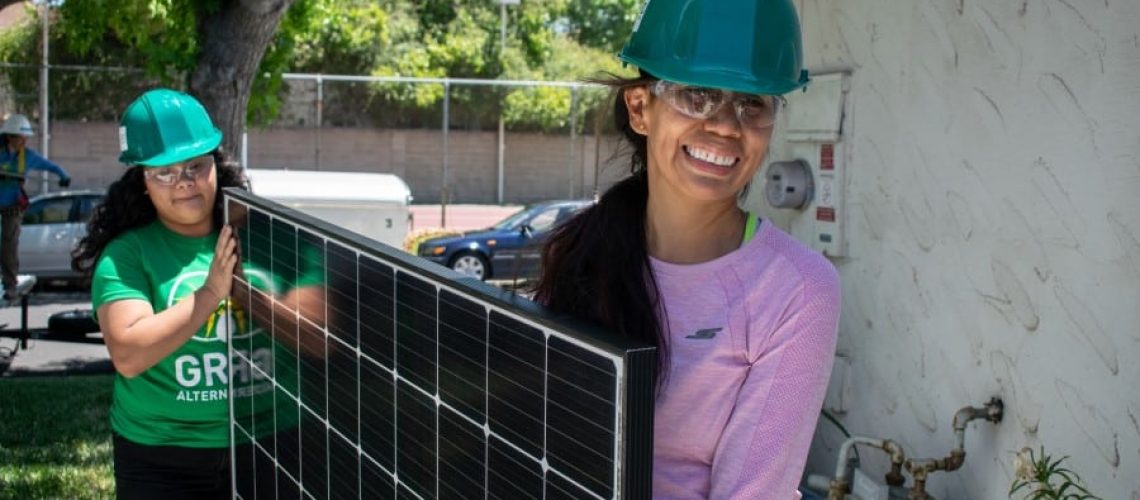The solar industry was supercharged by the historic Inflation Reduction Act (IRA), which not only supports deployment of solar PV through the extension of tax credits, but also creates incentives for U.S.-based manufacturing. The flip side of all this good news is that the industry now faces a substantial shortage of skilled labor. This includes electricians as well as workers trained in constructing and installing solar, batteries, electric vehicle (EV) chargers, and operations and maintenance (O&M) personnel.
“In 2022, 44% of employers said it was very difficult to find qualified applicants for open positions,” said Richard Lawrence, program director at the Interstate Renewable Energy Council (IREC).
The problem will only get worse as solar jobs will nearly double in the next 10 years from 263,000 today to 478,000 by 2033, according to a SEIA factsheet, though more than one in five of those jobs will be in manufacturing.
For most readers of Solar Builder, though, it’s the availability of “boots on the roof” that raises most of the concern. A shortage of skilled tradespeople could hamper the growth of companies ranging from smaller residential installers to the largest utility-scale EPCs.
Of course, state-level solar incentives still play into the industry’s health (<cough> California, <cough> NEM 3.0), but overall, the solar industry has never looked healthier. A residential solar installation workforce that is harmed by a utility commission’s whims are likely to find their skills are transferable to other parts of the industry.
If finding the right people to fill all those new positions seems daunting, the good news is that industry groups are working together to close the gap, with a focus on boosting formal and on-the-job training programs, and building a more diverse workforce.

Upskilling through formal apprenticeship programs
The largest change in how the industry builds the workforce comes from an IRA requirement: To get the full tax credits on a 1 MW or larger clean energy project, 15% of “laborers and mechanics” must be in a Registered Apprenticeship Program (RAP). For projects started in 2023, the requirement is 12.5%.
“We’re not just talking about recruiting a workforce, but we’re talking about the structure in which that workforce is managed and trained,” said Erika Symmonds, VP of equity and workforce development, Solar Energy Industries Association (SEIA). “Right now, there’s a lot of figuring out, how does that look? How do we do that successfully?”
In August, the Department of Labor selected IREC to lead the Apprenticeships in Clean Energy (ACE) Network to help employers build out apprenticeship programs.
“The apprenticeship system aligns with IREC’s mission and values to bring quality training to the industry, and to align that with the career pathways and long-term job outlooks, rather than just short-term training,” Lawrence said.
The ACE Network offers a range of resources for companies looking at formal apprenticeships, especially those new to apprenticeship programs. It is designed to “help employers understand the apprenticeship system, understand the options that are available,” Lawrence said. “A lot of what we do is get the word out about the benefits of apprenticeships and how to navigate that system. We also have technical assistance so we can help them start up programs and help connect them to existing programs in the area. And we also have some financial assistance available.”
While gaining skills under the guidance of a more experienced colleague is nothing new, a RAP ensures paid employees receive formal on-the-job training and related technical instruction under the supervision of a mentor. Employees gain an industry-recognized credential, Lawrence said, which shows “they’ve completed a comprehensive training program for a particular occupation,” in contrast to training that offers narrowly focused skills to do a particular job.
While solar installation is not a separately defined occupation for a RAP yet, most solar workers’ roles fall into a relevant occupation:
- Construction Craft Laborer,
- Electrician (Inside Wireman),
- Electrician (Lineman),
- Electrician (Residential Wireman),
- Operating Engineer,
- Carpenter (Pile Driver),
- Roofer, or
- Iron Worker.
Lawrence says that while a formal apprenticeship program may add an administrative burden for companies that have never offered formal training, it’s unlikely to be a barrier because most companies already “have a way to make sure that new workers are going to be supervised and that they’ve demonstrated their knowledge before they’re left alone by themselves to do work.”

Providing a variety of pathways
Solar workers have several pathways to enter the industry even without a formal apprenticeship. Along with learning on the job, employees can add skills through courses on an ad hoc or structured basis and can pursue industry-recognized NABCEP accreditation.
Nonprofit organizations like Solar Energy International (SEI) and GRID Alternatives started out playing a pivotal role in providing pathways for individuals seeking entry into the solar job market, and they have broadened their scope to help the industry scale.
SEI not only offers a curriculum that can be taken by an individual and paired with on-the-job training, says Chris Turek, VP of marketing and business development, but SEI also works with larger employers to build out comprehensive training programs via the SEI Engage program. SEI has also licensed its curriculum to community colleges, workforce training centers, and trade associations, with the goal of making consistent and thorough training widely available.
With online and in-person training options, SEI can help both complete beginners and more experienced workers. “Right now, it’s about a 50:50 split of students having no connection to the solar industry yet and already actively working in the solar industry,” Turek said.
Action items: Build skills and grow the pipeline of solar workers
- Reach out to local community colleges and trade schools to encourage them to offer solar-relevant training and connect them with SEI if they need help developing a curriculum.
- Identify any formal training needed to build your team’s skills beyond the on-the-job training.
- Connect with ACT Network to get help developing an apprenticeship program.
- Hire a summer intern, help them understand solar career paths, and encourage them to share their experience with friends.
- Take a look at how your workplace can welcome all new workers.
Similarly, GRID, which initially had a model similar to Habitat for Humanity, has moved away from volunteerism and less-structured hands-on work experience to a defined curriculum for people actively seeking to enter the workforce, said Adewale OgunBadejo, VP of workforce development at GRID Alternatives. GRID trains entry-level workers through its own affiliates and partnerships with nonprofits such as Goodwill in Nashville and with tribal groups.
Both SEI and GRID work closely with employers to ensure their training addresses industry needs, expanding their curricula to include new skills, such as installing battery and EV chargers, and performing O&M.
People entering the industry may target many roles outside of construction and O&M, such as permitting, project management, sales, or accounting. Few of those roles align with registered apprenticeship programs or other solar-focused training, though they still require on-the-job training to tailor skills to the industry.
Ensuring success for a wider workforce
Increasing diversity is key to growing the workforce. Building a more diverse workforce is a moral imperative as well as a strategic necessity — tapping a wider group of potential workers is critical to feed the industry’s insatiable need for talent.
“Building an equitable, inclusive, and diverse industry is really a necessity,” OgunBadejo said. “You have to reach deeper to identify the talent. That means going into local communities in a way that we haven’t before to find that talent and get them trained up and get them ready to move into the industry.”
The most recent National Solar Job Census showed that there’s still a significant gap between the industry’s diversity and country’s overall workforce. Women make up just 31% of the solar workforce, and only 9% of the solar workforce is African American, much less than the 13% in the overall workforce. The industry also skews young, with only 13% of workers 55 and over, compared to 24% in the overall workforce.
One area where solar leads? Hiring veterans. U.S. veterans make up 8% of solar employees, well above the 5% in the overall workforce.
“We have a job as an industry to remove the barriers of entry, as many barriers as possible, for prospective workers so that they know what their options are, and they can make educated decisions about which pathway to go,” Symmonds said.
GRID is a model of what training local, diverse communities looks like, said OgunBadejo. ”We have the opportunity to show what diversity could look like in this industry. The intentionality needs to be there, and there needs to be public-private partnerships, and a commitment to ensuring that the transition to clean energy is just. GRID wants to be a thought partner and an implementer.”
Another aspect of growing a diverse workforce is ensuring that training meets the needs of non-English speakers. SEI offers online training in Spanish as well as English, while GRID trains people in Spanish in Puerto Rico and some international locations.
Just sourcing a diverse range of talent is not enough, OgunBadejo said. To ensure the pipeline of new workers is given the highest chance of success, employers need to foster a welcoming environment for a wide range of candidates.
“One of the most disappointing things is a lot of times somebody walks into an opportunity, and it’s really not set up for them. The space is not comfortable, it’s not equitable, maybe, at a company that has never really had to think about diversity,” he said. “An individual could go to three or four solar companies before they’ve been in the industry for a year. If they have determination, they’ll stay in the industry and find their way eventually, but for a lot of other people, it can be discouraging.”
Some of the nonprofits in workforce development understand soft skills training or other support may be needed by some candidates, OgunBadejo said, as they may face issues such as housing insecurity, little financial literacy, or poor access to health or childcare.
Expanding the solar workforce is inherently tied to expanding access to solar energy in lower income communities. Example: The Georgia BRIGHT Solar leasing program offered by Capital Good Fund is a leasing program (no upfront cost) for homeowners making less than $100,000 a year. “Georgia BRIGHT is a discount solar lease program that saves LMI homeowners money starting day one,” says Capital Good Fund Chief Business Officer Aisha Bussey.
As part of the program, Capital Good Fundworks with local installers, Sunpath Solar, Better Tomorrow Solar, and Be Smart Home Solutions, which will all provide employment opportunities and training from within the LMI communities in which the solar systems will be installed.
Spreading the solar jobs gospel
All the solar training and apprenticeship programs in the world will mean nothing if people don’t know about the opportunities and feel encouraged to enter the industry.
“One of the challenges that we have as an industry is we also need to not only make sure that those good paying jobs and careers are there for these folks, but to also make sure that we’re doing a good job of highlighting how fun this work is, and how meaningful this work is,” Turek said.
Symmonds said engaging younger workers through internships and work experience can have a ripple effect. “Getting them in the door, getting them excited: if you could get a well-paid summer internship for high school or in college that outdoes any of your friends,” it will provide a carrot to tempt others into the industry.
She challenges solar companies to create great work-based opportunities for younger people “so that they get wrapped in and see value and feel connected to the space.”
Dej Knuckey is a contributor to Solar Builder. She is a journalist, author and freelance writer who has covered energy for publications in Australia and the U.S.
Tags: commercial and industrial, Grid Alternatives, installers, SEIA, solar apprenticeship programs, workforce



